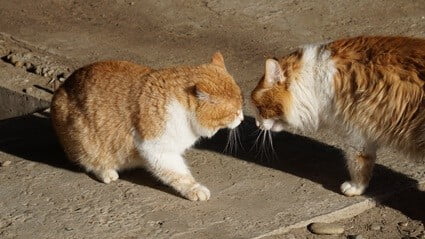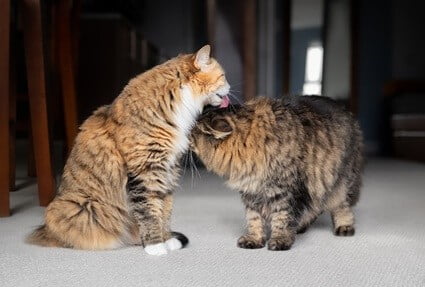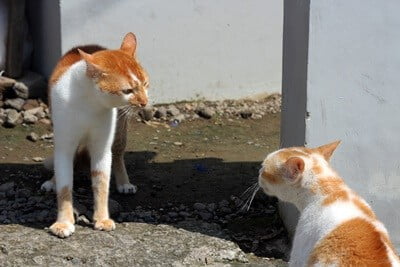Despite living with humans for millennia, cats are still viewed as asocial creatures. Unlike lions, they do not stick together in prides. In rare cases, a group of feral cats will form if there’s a common food source that they don’t have to fight over. That makes the social hierarchy of cats unique, especially when they’re kept together as pets.
When cats are exerting their dominance, they will stiffen their ears and rotate them sideways. This is matched to standing upright, prolonged staring, and raising the base of their tail (while drooping the tip). Verbal displays of dominance include hissing and yowling. Indirect displays include spraying (urinating) and bunting (scent rubbing). If a fight ensues, one cat will bite the other’s neck while the weaker cat rolls over to scratch its opponent’s stomach with its hind legs.
In a technical sense, there are no ‘alpha’ or ‘beta’ cats. In fact, there isn’t a strict hierarchy at all. Researchers theorize that cats’ ability to form groups is a recent development, almost as recent as their domestication. Because of this, we may wrongly compare them to dogs or even primates, thinking one of them needs to be in charge of the others. The social patterns of cat groups are actually very different.
Alpha Cat Personality
The concept of “alpha” behavior in animals comes from a now-debunked 1970s study on wolf packs. Although the results of the study were proven to be incorrect, the term “alpha” stuck.
It’s associated with dominant and aggressive behavior in animals (and sometimes humans). This has become the go-to word to describe specific, circumstantial social interactions.
The problem with the word “alpha” is that it implies a permanent social hierarchy. This doesn’t exist, especially in cats. If you are raising multiple cats and notice that some of them frequently yield to a more aggressive cat, don’t be fooled. This is a far more nuanced social interaction than simple alpha and beta dynamics.
Social hierarchy in cats is a lot looser than you think for multiple reasons. The existence of a dominant animal in a group implies something incorrect: That the alpha and the rest of the pack have an innate understanding of how social structures work within their species. For animals to develop such innate understandings, they have to be social animals.
Domestic cats (Felis catus) are not traditionally social creatures. There is no evidence that any of their ancestors in the Felis genus formed groups. This leads experts to believe that cats forming clowders is a recent occurrence. In fact, it’s as recent as the beginning of their domestication, over 10 million years ago.
Dominant Behavior in Cats
Cats have only recently (and infrequently) needed to form social groups. As such, the behavioral patterns witnessed in clowders are too inconsistent to be deemed a true hierarchy. Social animals (such as primates and dogs) tend to have a hierarchy that is much more:
- Stable
- Predictable
- Easy to study
According to the Journal of Veterinary Behavior, cats lack ritualized submissive signals. Any defensiveness they show in the face of aggression, unlike other animals, does not indicate:
- Reproductive success
- Priority access to resources
Dominance Theory was postulated in a 1970s study done on wolves. It states that in a pack, one male wolf was naturally more aggressive than others. It was born to lead due to a constant exertion of its dominance. However, a big reason this does not apply to cats (apart from the study being wrong) is that they are not naturally aggressive.
According to Scientific Reports, aggressive behavior in cats is largely due to early weaning. Cats, in general, try to avoid fights as often as they can. Hormones lead male cats to experience heightened levels of aggression when a nearby female is in heat. However, this is circumstantial.
In fact, the term “scaredy cat” likely comes from how easily frightened cats are. That’s very different from the tough, aggressive “alphas” you would believe them to be.
How to Tell if Your Cat is An Alpha
So, now we know that cats don’t have a strict hierarchy where the strongest, most aggressive cat is the leader. Likewise, cats aren’t born with specific “leader” traits that make them an alpha. So, why do some cats appear more in charge than others?
If you look closely, you may find the cats in your house are actually ‘taking turns.’ Because they don’t have a hierarchy, they bend to the whims of others or enforce their own desires based on the moment. For example, imagine one cat desires the sunning spot next to your window. The other cats might allow it because they’re:
- Uninterested
- Busy with other things
- Napping
- Don’t feel like play-fighting (or real-fighting) for it
Just as easily, another cat may decide to take over that spot. Perhaps it wants to sun there instead, or perhaps it just wants to stir up trouble because it’s feeling bored. The original cat’s ability to keep that spot doesn’t depend on its rank. It just depends on its mood and the mood of the other cats.
Why Is My Cat In Charge?
With that said, you may find that some cats do start fights and enforce their will constantly. If this is the case, high levels of aggression in cats stem from the:
- Early rearing process
- Current home environment
Experiencing stressful situations triggers aggressive behavior out of fear and mistrust. This isn’t caused by a need to exert dominance. If those experiences happen while the cat is young, then it can set the cat up for a life of neurotic behavior.
A single house cat that acts haughtily around its owners might cower in fear at the sight of a friendly, neighborhood cat. That same house cat might feel better bullying a kitten instead.
Alpha Kittens
In kitty litters, there might be one kitten that is bigger than the rest. It can then push the others out of the way to get milk faster. This does not mean that the bigger kitten will grow up to have a dominant personality. It just means that its size gives it an advantage over the rest. It could still grow up to be timid.
The other kittens in the litter that could potentially be more aggressive are just too young and too small to do anything about it at the moment. It’s impossible to determine which cats are “alphas” as kittens.

Dominant Cat Body Language
According to Science Direct, even feral groups do not have a linear hierarchy. They use subtle hints to communicate their intent to take, defend, or leave resources. As pets, cats will initially communicate in this way and display signs of aggression until they reach an understanding.
Cats will divide the territories all over the house, but those aren’t permanent agreements. Snuffles may have yielded and given Cookie the couch. However, one day, Snuffles might decide she wants the couch for herself and stand up to Cookie. If she’s successful, ownership of the couch territory transfers over to Snuffles. That is until she decides to give it up or another cat takes it by way of threats.
Cats are more likely to share space than fight for it if they’re:
- Paired
- Have been raised together for years
- Have friendly personalities
When fighting for resources, cats have multiple direct and indirect ways of securing what’s theirs. This includes:
Direct Confrontation
Direct confrontation is when two or more cats are facing off directly. Cats that do not want to back down will warn and threaten their opponent with:
- Intense staring
- Stiffening of the ears
- Rotating the ears to the side
- Raising the base of the tail while lowering the tip
- Stiffening the limbs
- Standing upright
When neither cat wants to back down, they will get physical with each other. One cat (usually the more aggressive or agile one) will lunge for the other’s neck. Meanwhile, the weaker one rolls over to scratch its opponent’s belly with its hind legs.
Cats quickly disengage after getting physical. However, they will then tackle one another again and keep going until one of them decides to give up.
Verbal Confrontation
Cats will often communicate their intent verbally. Friendly verbal communication includes purring, trilling, and the cat’s usual meow. Sounds issued in a low tone are almost always aggressive. This also includes sounds made with the cat’s mouth wide open (to bare its teeth). Cats are verbally confronting each other when they are:
- Shrieking
- Yowling
- Growling
- Hissing
- Snarling
Indirect Confrontation
Indirect confrontation is when a cat uses preventative measures to secure resources. To ignore these measures can be seen as a direct confrontation. Indirect confrontation includes:
- Urinating
- Bunting
- Spraying
- Allorubbing
Urinating and spraying are different things. Spraying is when the cat quivers its tail and sprays urine on a vertical surface. Although cats urinate and spray to mark their territory, spraying displays more obvious intent.
Alpha Female Cat Behavior
Alpha traits and aggression are usually associated with the males of any species. However, female cats may be just as aggressive as males. Feral clowders are matriarchal, though there is no one female leader. The females take turns:
- Caring for the litter
- Searching for food
- Scaring away intruders
Close female bonds form in feral clowders. Female cats den together when giving birth and will support each other through the process. They almost behave like midwives. They nurse each other’s kittens and aggressively fight any male that tries to kill the kittens to bring back the females’ heat.
Female house cats are no different. They can be just as aggressive and territorial as the males. However, they are a lot less likely to engage in physical altercations.
Can You Introduce An Alpha Cat To Your Other Cats?
If you have a multi-cat home, and the cats get along well with each other, you may want to introduce a new cat. Think twice before you do. The introduction of a new kitten or adult cat into an already-established dynamic can disrupt a group. This will bring out their aggressive side.
A new cat means that everyone will have to renegotiate their territories before they are ready to. This leads to stress and even more aggression. Worse yet, that new cat may not be a team player because of its personality and genetics.
Many behavioral issues in cats can be trained out, but some cats aren’t meant to live in groups. According to another study from the Journal of Veterinary Behavior, the state of a cat’s oxytocin receptor gene determines its aggression levels. It showed that genetic variation determines a cat’s personality.
Aggressive cats with a single receptor grew even more aggressive with age. A new cat can learn to integrate with the rest with proper behavior training. However, some cats are genetically predisposed to being alone.
How to Tame an Alpha Cat
Alpha or no, if you have one cat that’s aggressive to the point of endangering the others, you need to control it. What fuels your cat’s aggression is something you will only find out through trial and error. Most likely, the source of the aggression comes from:
- Some form of stress
- Poor socialization
- An underlying illness
Illness
Unhealthy cats feel scared and vulnerable. If they have the strength to do so, they drive off other cats by being aggressive. One quick visit to the vet can confirm whether or not your cat’s behavior has to do with its health. Health-related aggression is usually matched to sudden behavior changes that persist long-term.
Poor Socialization
Cats learn how to communicate with each other while growing up with their siblings and mother. Cats that were separated from the litter too young have trouble understanding certain signals.
For example, they confuse friendly behavior with aggression and act out of self-defense—cats like these need to be given a lot of space. You should give the aggressive cat as much attention as the others. Never try to force interactions between them.

Stress
Stress is one of the most common reasons for cats to lash out. It’s also a big reason why cats don’t have permanent social structures. A single stressful event can make a timid cat disrupt the group dynamic and become the bully, even if it’s only temporary.
Many things can stress a cat out. You have to be observant and take note of the body language after you do certain actions. This will help you eliminate the cat’s source of stress.
How Do Cats Show Submission?
When cats fight, one must yield so the other can become the victor. The one who yields communicates its intention to leave by:
- Flattening its ears
- Looking away
- Curling its tail against its thigh
- Tucking its tail between its legs
- Crouching
- Rolling over
Cats won’t only display these signs of submission to other cats. If your cat ever does this, it’s scared of:
- An object
- Another animal
- A loud noise
- A person
Just because a cat displays signs of submission doesn’t mean it’s not aggressive. Do not approach a cat with submissive body language. At any moment, it can gather its courage and attack.
It’s also important to watch out for aggressive and defensive body language when introducing new cats and kittens. For this precise reason, they can be dangerous to you and others. It’s best to disengage, avoid eye contact, and wait for the cat’s body language to go back to a neutral or resting position.

